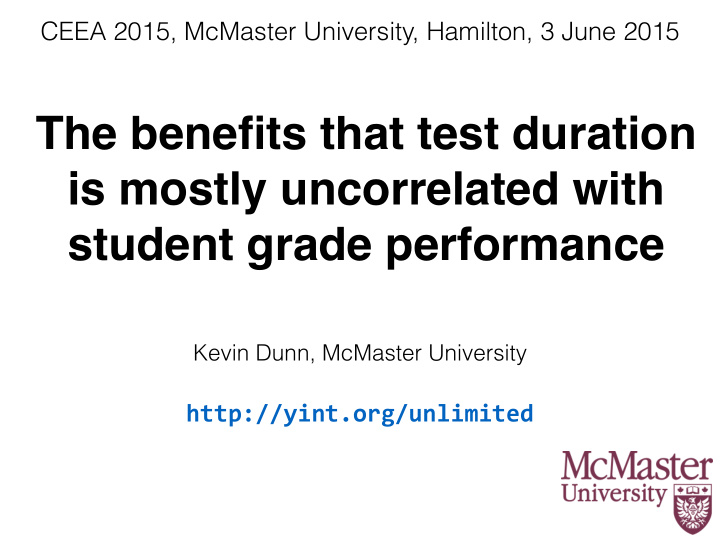



CEEA 2015, McMaster University, Hamilton, 3 June 2015 The benefits that test duration is mostly uncorrelated with student grade performance Kevin Dunn, McMaster University http://yint.org/unlimited
Have you experience these issues regarding tests/exams? • How many questions? • Material to test? • Depth of questions? • Seen students writing furiously until the end of the test?
What we can learn from this presentation Time-pressure induced anxiety is real and can lead to lower grades [Onwuegbuzie & Seaman (1995); Orfus (2008)] Removing time-pressure leads to a fairer assessment of the student’s capability Practical tips for reducing time pressure in your tests
If only I had more time … Time-pressure induced stress on the student’s side: This happens to a subset of students. There is a “Text Anxiety Inventory” and “Test Anxiety Scale”
Being “in-control” of your time Case and Gunstone: 2nd year chemical engineering students. “ saving time ” “ time caught up with me ” “ time’s not on your side ” “ spending time ” Unlimited time tests: “instructor wanted to emphasize that it was the understanding (deep learning) that mattered”
What if we take time-pressure away? Unlimited time tests What we tried: Set the test for a typical duration: e.g. 2 hours Students can stay and write as long as they require Open notes, any papers, any textbook, any calculator allowed We record the time the student leaves on the attendance list
This is not cause and effect ! • Staying longer in the test is associated with a small decrease, or no change in their test grade. • Can we find out the mechanism going on here? 1. Strategizing 2. Self-doubt
What actions to take from this If learning outcome is not time-based retrieval and not time-based transfer of knowledge, then give student’s time. Case and Gunstone quote
Conclusion Practically, we have time limits. Set tests and exams that require 50 to 60% of the allocated time. Clearly communicate that you have done that. Quote: Having open book and no time limit on the midterm relieved all the stress and allowed me to really convey my knowledge and ability a lot more effectively. Please don’t ever stop doing this.
All the data are available http://yint.org/unlimited • The raw data from 8 tests • This presentation • The R script for the data analysis, and figures in in the paper and this presentation
References and Credits • Onwuegbuzie & Seaman, “The Effect of Time Constraints and Statistics Test Anxiety on Test Performance in a Statistics Course”, The Journal of Experimental Education , 63 (2), 1995. • Orfus, “The effect test anxiety and time pressure on performance,” The Huron University College Journal of Learning and Motivation , 46 (1), 2008. • Case and Gunstone, “Going deeper than deep and surface approaches: A study of students’ perceptions of time”, Teaching in Higher Education , 8 (1), 2003. DOI: 10.1080/1356251032000052320 • Students writing exam photo: https://www.flickr.com/photos/cristic/359572656 • Clock photo: https://www.flickr.com/photos/thenextadventure/6326965400 • Stress illustration: https://www.flickr.com/photos/seaternity/14097113502 • Desks photo: https://www.flickr.com/photos/comedynose/6766568985/in/photostream • Bloom’s taxonomy illustration: http://www.celt.iastate.edu/teaching-resources/effective-practice/revised-blooms-taxonomy/
Recommend
More recommend